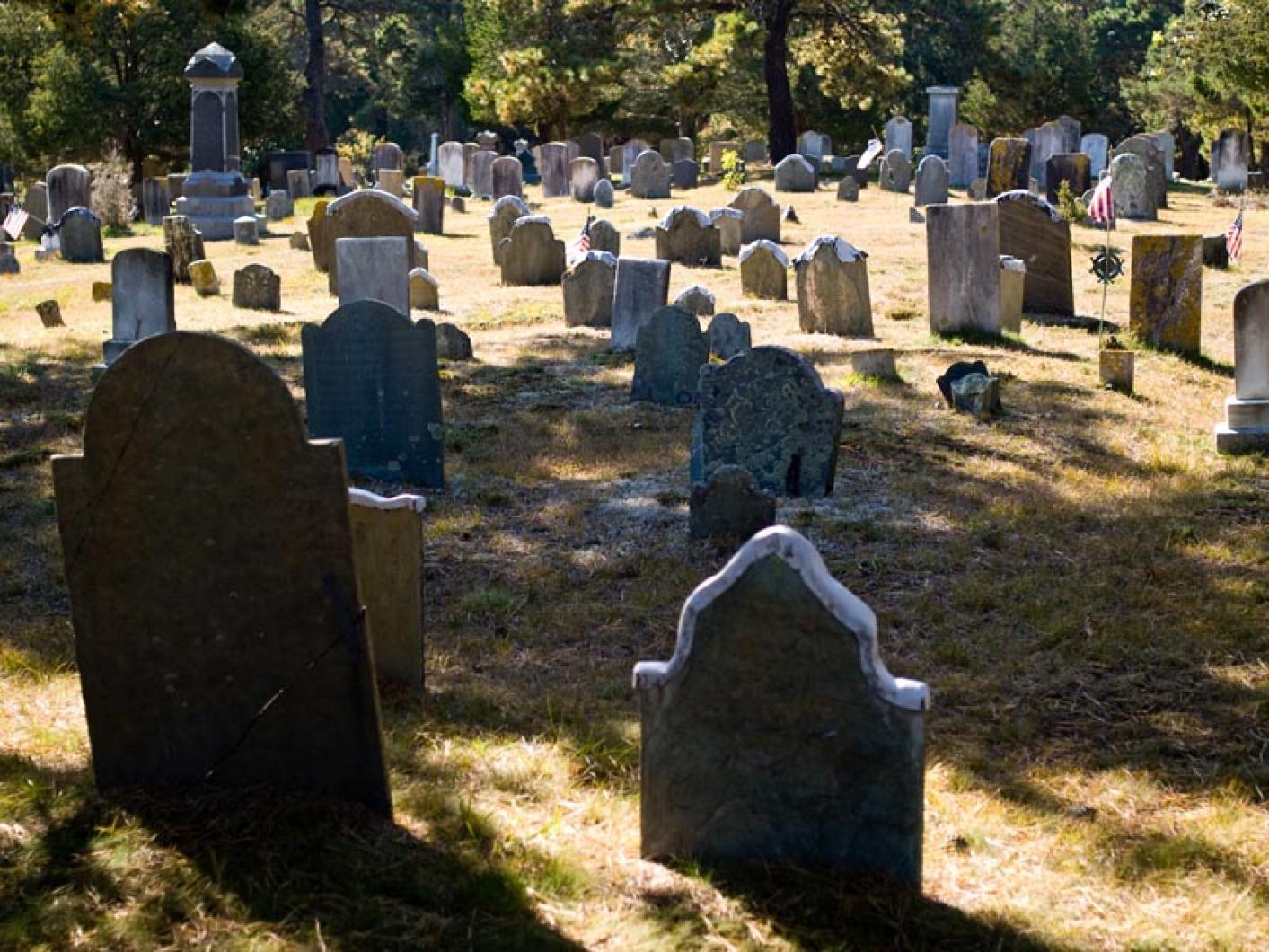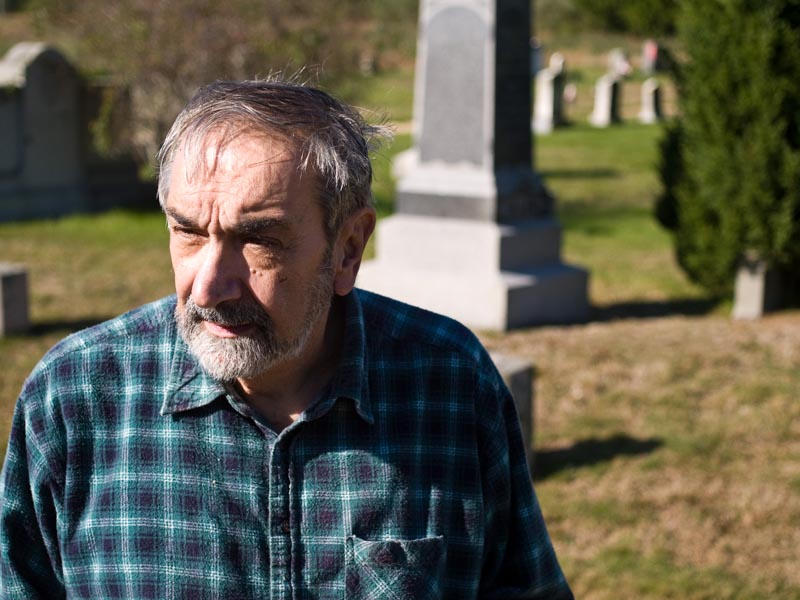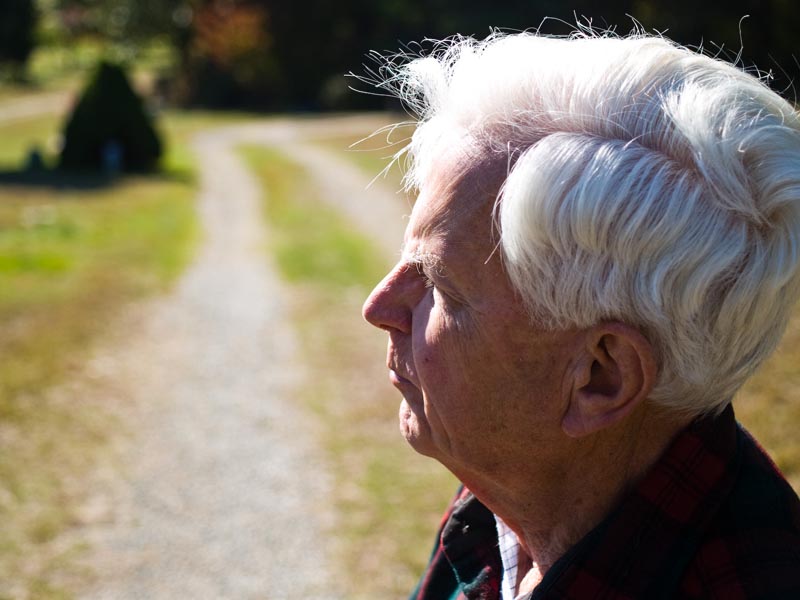When John Alley was a kid, his Uncle Fred would pay him to mow the lawn at the West Tisbury cemetery. One day, just as he was leaning over between two headstones, he felt a hand on his shoulder. Young John headed for the hills.
“That was it! I lost the lawnmower and ran,” remembered Mr. Alley, thinking one of his silent friends had come back from the dead. Turns out it was just Prudy Whiting letting young John know that her father’s sheep were on the loose.
While stories of ghouls and ghosts intrigue many when thinking about graveyards (particularly at this time of year), for Mr. Alley the rich history of Island folks means more than pranks and hoaxes.
“Each cemetery has a different character,” he said. “It plays host to the families that originally settled into the towns.”
Walking through the cemetery, Mr. Alley recalled other tales (embellished at his will) about his early days in the graveyard. He has been cemetery superintendent for about 30 years.
The last grave he remembers digging was for H. Keyes Chadwick, a man known for his duck decoys. While Mr. Alley was shoveling away, an unexpected storm caused a lightning bolt to hit 50 feet away.
“I said to myself, I’ll be going now,” said Mr. Alley. “I had to get the devil out of there!”
On another occasion, while tending the graves, he heard what he thought was a radio playing.
“I came over the top of the hill and it was these folks chanting,” he said, describing a group of ladies surrounding Nancy Luce’s grave. “Honest to God, women will come here, dressed in white, they all lock arms, and they sit in a circle around the stone. And every time they come here, they leave a chicken.”
Indeed, Ms. Luce’s grave has a cozy collection of decorative chickens around it. Ms. Luce lived during the 19th century and was known to bury her farm’s beloved pet chickens and inscribe poems on their gravestones.
Passing by his own family’s plot, Mr. Alley told of how his Portuguese grandfather took the name Alley. As a young fisherman, the elder Mr. Alley used to call out his catch upon returning to the Island. Halibut was hard for him to say in English, though, and sounded more like Alley-but.
Next on the tour is Ole Borgen, which had Mr. Alley dreaming (drooling) of the old ice cream shop owned by Mr. Borgen, now the site of Bananas Gallery. And nearby lies Captain Donaldson, the original owner of the West Tisbury gas station.
Across the way, the names Whiting, Athearn and Manter stand out on bold monuments, as well as William J. Rotch, the celebrated father of the town. In addition to the many farmers, the West Tisbury graveyard contains a handful of men who died in the Civil War and even one who died during the California gold rush.
The cemetery also boasts the oldest grave on the Island, that of John Mayhew, son of missionary Thomas Mayhew, who was buried in 1688. Liz Villard, a member of the Martha’s Vineyard Historical Society who gives graveyard tours, said that she very much doubted he was the first to die or be buried on the Island. She said many people could not afford gravestones in earlier centuries, thus accounting for the small family plots.
“Today we call up the funeral parlor and they take the body and it can be buried,” said Ms. Villard. “But back then, you just dug a hole in the backyard.”
Some may be marked by plain field stones, while others have no indication at all.
Small burial grounds like these can be found in Aquinnah, Chappaquidick and Christiantown. At Abel’s Hill, sharp stones pop up among the smooth graves like wild mushrooms with no particular placing.
Jane Slater, Chilmark cemetery commissioner, said the unmarked graves could belong to Native Americans, small pox victims or seamen.
“If you washed ashore, they took you up here and buried you,” she said. “And a lot of those graves are unmarked because it was the custom of the Wampanoags.”
The cemetery’s namesake, Abel Wauwompuhque, nephew of the first preacher of the Gay Head church, donated the original land to the town so as to include Native Americans since there was no burial ground in Aquinnah at the time.
Even those with inscriptions have faded in time.
Historical women figures at the Abel’s Hill graveyard include the first female physician in the country, Elizabeth Blackwell, and playwright and author Lillian Hellman.
Women play prominent figures in the Tisbury cemeteries, too. In fact, Ms. Villard said the graveyard behind the Katharine Cornell Theatre was created solely for a lady. The story resembles Romeo and Juliet, with the Mayhews and Daggetts playing the part of the Montagues and Capulets. When Deborah Mayhew married a Daggett she was disowned. When she died, neither the Daggetts nor the Mayhews would accept her in their family plots and her husband had to create a new cemetery to honor her memory.
In Edgartown, whaling captain titles adorn many graves. The ornamental headstones pay tribute to the importance and wealth of these men, including figures like Dr. Daniel Fisher. And yet, although Dr. Fisher’s stone may be beautiful and elegant, it has no epitaph or date.
“That’s the fascinating things about graveyards,” said Ms. Villard. “I can do the research, but in the end you are left with an enigma like that.”
Beyond the white picket fence looking west, sugar maples turning orange hover over the more modern section of the cemetery.
“On the other side of the road is ordinary people,” said Ms. Villard. “Like you and me.”
Click here for more photos of the Island's cemeteries.










Comments (2)
Comments
Comment policy »